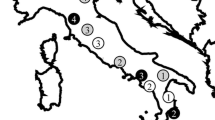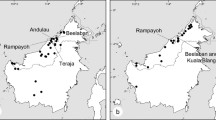Abstract
Sophronitis sincorana and S. pfisteri (Orchidaceae) are endemic to the campo rupestre vegetation, northeastern Brazil, occurring sympatrically and flowering synchronously. In this work we studied the reproductive biology of both species and investigated reproductive barriers between them. Both species are partially self-compatible, pollinator dependent, and are pollinated by males and worker bees of Bombus brevivillus. Pollinaria are deposited on the anterior portion of the mesonotum of these insects in S. pfisteri, and on the scutellum in S. sincorana. The flowers of both species are deceptive, as they have a dry cuniculus. Morphological differences in the labellum and the gynostemium impede inter-specific pollination of S. pfisteri with pollen from S. sincorana. Very low fruiting results from inter-specific crosses of S. sincorana with pollen from S. pfisteri. Although viable seeds can be produced from experimental inter-specific crosses, no natural hybrids were found. Species integrity appears to be maintained by additive unidirectional reproductive barriers between them.
Similar content being viewed by others
References
Arditti J (1992). Fundamentals of orchid biology. Wiley, New York
Ayres M, Ayres M Jr, Ayres DL and Santos AS (2003). BioEstat 3.0: aplicações estatísticas nas áreas das ciências biológicas e médicas. Sociedade Civil Mamirauá and MCT–CNPq, Belém
Bawa KS (1974). Breeding systems of tree species of a lowland tropical community. Evolution 28: 85–92
Borba EL and Braga PIS (2003). Biologia reprodutiva de Pseudolaelia corcovadensis (Orchidaceae): melitofilia e autocompatibilidade em uma Laeliinae basal. Rev Brasil Bot 26: 541–549
Borba EL and Semir J (1998). Bulbophyllum ×cipoense (Orchidaceae), a new natural hybrid from the Brazilian “campos rupestres”: description and biology. Lindleyana 13: 113–120
Borba EL and Semir J (1999). Temporal variation in pollinarium size after its removal in species of Bulbophyllum: a different mechanism preventing self-pollination in Orchidaceae. Pl Syst Evol 217: 197–204
Borba EL and Semir J (2001). Pollinator specificity and convergence in fly-pollinated Pleurothallis (Orchidaceae) species: a multiple population approach. Ann Bot 88: 75–88
Borba EL, Shepherd GJ and Semir J (1999). Reproductive systems and crossing potential in three species of Bulbophyllum (Orchidaceae) occurring in Brazilian `campo rupestre' vegetation. Pl Syst Evol 217: 205–214
Borba EL, Shepherd GJ and Semir J (2001). Self-incompatibility, inbreeding depression and crossing potential in five Pleurothallis (Orchidaceae) species. Ann Bot 88: 89–99
Borba EL, Funch R, Ribeiro PL, Smidt EC, Silva-Pereira V (2007) Demography, genetic and morphological variability of the endangered Sophronitis sincorana (Orchidaceae) in the Chapada Diamantina, Brazil. Pl Syst Evol (in press). DOI: 10.1007/s00606-007-0555-9
Buzato S, Sazima M and Sazima I (2000). Hummingbird-pollinated floras at three Atlantic Forest sites. Biotropica 32: 824–841
Cameron AS and Williams PH (2003). Phylogeny of bumble bees in the New World subgenus Fervidobombus (Hymenoptera: Apidae): congruence of molecular and morphological data. Molec Phylogenet Evol 28: 552–563
Chiron GR and Castro VP (2002). Révision des espèces brésiliennes du genre Laelia Lindley. Richardiana 2: 4–28
Catling PM (1982). Breeding systems of northeastern North America Spiranthes (Orchidaceae). Canad J Bot 60: 3017–3039
Cozzolino S and Widmer A (2005). Orchid diversity: an evolutionary consequence of deception?. Trends Ecol Evol 20: 487–494
Cozzolino S, D'Emerico S and Widmer A (2004). Evidence for reproductive isolate selection in Mediterranean orchids: karyotype differences compensate for the lack of pollinator specificity. Proc Roy Soc London Ser. B Biol Sci 271(Suppl. 5): S259–S262
Cozzolino S, Nardella AM, Impagliazzo S, Widmer A and Lexer C (2006). Hybridization and conservation of Mediterranean orchids: should we protect the orchid hybrids or the orchid hybrid zones? Biol Conserv 129: 14–23
Dafni A and Calder DM (1987). Pollination by deceit and floral mimesis in Thelymitra antennifera (Orchidaceae). Pl Syst Evol 158: 11–22
Dodson CH (1962) The importance of pollination in the evolution of the orchids of tropical America. Amer Orchid Soc Bull 31: 525–534, 641–649, 731–735
Dressler RL (1981). The orchids: natural history and classification. Harvard University Press, Cambridge
Dressler RL (1993). Phylogeny and classification of the orchid family. Dioscorides Press, Portland
Gill DE (1989). Fruiting failure, pollinator inefficiency and speciation in orchids. In: Otte, D and Endler, JA (eds) Speciation and its consequences, pp 433–457. Sinauer Associates, Sunderland
Giulietti AM and Pirani JR (1988). Patterns of geographic distribution of some plant species from the Espinhaço Range, Minas Gerais and Bahia, Brazil. In: Heyer, WR and Vanzolini, PE (eds) Proceedings of a workshop on neotropical distribution patterns, pp 39–69. Academia Brasileira de Ciências, Rio de Janeiro
Giulietti AM, Pirani JR and Harley RM (1997). Espinhaço range region. Eastern Brazil. In: Davis, SD, Heywood, VH, Herrera-Macbryde, O, Villa-Lobos, J, and Hamilton, AC (eds) Centres of plant diversity: a guide and strategy for their conservation, Vol 3, pp 397–404. The Americas. World Wildlife Foundation and IUCN, Cambridge
Harley RM (1988). Evolution and distribution of Eriope (Labiatae) and its relatives in Brazil. In: Heyer, WR and Vanzolini, PE (eds) Proceedings of a workshop on neotropical distribution patterns, pp 71–120. Academia Brasileira de Ciências, Rio de Janeiro
IUCN/SSC Orchid Specialist Group. (1996) Orchids – Status survey and conservation action plan. IUCN, Gland Switzerland and Cambridge
Janzen DHP, Devries P, Gladstone DE, Higgins M L and Lewinsohn M (1980). Self- and cross-pollination of Encyclia cordigera (Orchidaceae) in Santa Rosa National Park, Costa Rica. Biotropica 12: 72–74
Jersáková J, Johnson SD and Kindlmann P (2006). Mechanisms and evolution of deceptive pollination in orchids. Biol Rev 81: 219–235
Johnson SD, Steiner KE, Whitehead VB and Vogelpoel L (1998). Pollination ecology and maintenance of species integrity in co-occurring Disa racemosa L.f. and Disa venosa Sw. (Orchidaceae) in South Africa. Ann Missouri Bot Gard 85: 231–241
Köppen W (1948). Climatologia com un estudio de los climas de la Tierra (Transl. by Peres PRH). Fondo de Cultura Econômica, México
Levin DA (2000). The origin, expansion and demise of plant species. Oxford University Press, New York
Manuel R, Warren R, Miller D (1996) Sophronitis coccinea: a pollination study. Orchids 612–616.
Martin FW (1959). Staining and observing pollen tubes in the style by means of fluorescence. Stain Tech 34: 125–128
Matias LQ, Braga PIS and Freire AG (1996). Biologia reprodutiva de Constantia cipoensis Porto & Brade (Orchidaceae), endêmica da Serra do Cipó, Minas Gerais. Rev Brasil Bot 19: 119–125
Montalvo AM and Ackerman JD (1987). Limitations to fruit production in Ionopsis utricularioides (Orchidaceae). Biotropica 19: 24–31
Nilsson LA (1992). Orchid pollination biology. Trends Ecol Evol 7: 255–259
Pansarin E (2003). Biologia floral de Cleistes macrantha (Barb. Rodr.) Schltr. (Orchidaceae: Vanilloideae: Pogoniinae). Rev Brasil Bot 26: 73–80
Richards AJ (1997). Plant breeding systems, 2nd. Chapman & Hall, London
Sanford WW (1964). Sexual compatibility relationship in Oncidium and related genera. Amer Orchid Soc Bull 33: 1035–1048
Schemske DW and Lande R (1985). The evolution of self-fertilization and inbreeding depression in plants. II. Empirical observations. Evolution 39: 41–52
Scogin R, Young DA and Jones CE (1977). Anthochlor pigments and pollination biology: II. The ultraviolet patterns of Coreopsis gigantea (Asteraceae). Bull Torrey Bot Club 104: 155–159
Silva UF, Borba EL, Semir J and Marsaioli AJ (1999). A simple solid injection device for the analyses of Bulbophyllum (Orchidaceae) volatiles. Phytochemistry 50: 31–34
Singer RB and Sazima M (1999). The pollination mechanism in the “Pelexia alliance” (Orchidaceae: Spiranthinae). Bot J Linn Soc 131: 249–262
Smidt EC, Silva-Pereira V and Borba EL (2006). Reproductive biology of two Cattleya (Orchidaceae) species endemic to Northeastern Brazil. Pl Spec Biol 21: 85–91
Stebbins GL (1974). Flowering plants: evolution above the species level. Harvard University Press, Cambridge
Steiner KE, Whitehead VB and Johnson SD (1994). Floral and pollinator divergence in two sexually deceptive South African orchids. Amer J Bot 81: 185–194
Stort MNS and Galdino GL (1984). Self- and cross-pollination in some species of the genus Laelia Lindl. (Orchidaceae). Rev Bras Gen 7: 671–676
Stoutamire WP (1975). Australian terrestrial orchids, thynnid wasps and pseudocopulation. Amer Orchid Soc Bull 43: 13–18
Thien LB and Marcks BG (1972). The floral biology of Arethusa bulbosa, Calopogon tuberosus and Pogonia ophioglossoides (Orchidaceae). Canad J Bot 50: 2319–2325
Tremblay RL (1992). Trends in the pollination ecology of the Orchidaceae: evolution and systematics. Canad J Bot 70: 642–650
Tremblay RL, Ackerman JD, Zimmerman JK and Calvo RN (2005). Variation in sexual reproduction in orchids and its evolutionary consequences: a spasmodic journey to diversification. Biol J Linn Soc 84: 1–54
van den Berg C (2005). Sophronitis. In: Pridgeon, AM, Cribb, PJ, Chase, MW and Rasmussen, FN (eds) Genera Orchidacearum, vol. 4, pp 313–316. Oxford University Press, Oxford
van den Berg C and Chase MW (2000). Nomenclatural notes on Laeliinae – I. Lindleyana 15: 115–119
van den Berg C, Higgins WE, Dressler RL, Whitten WM, Soto Arenas MA, Culhan A and Chase MW (2000). A phylogenetic analysis of Laeliinae (Orchidaceae) based on sequence data from internal transcribed spacers (ITS) of nuclear ribossomal DNA. Lindleyana 15: 96–114
van den Berg C, Goldman DH, Freudenstein JV, Pridgeon AM, Cameron KM and Chase MW (2005). An overview of the phylogenetic relationships within Epidendroideae inferred from multiple DNA regions and recircumscription of Epidendreae and Arethuseae (Orchidaceae). Amer J Bot 92: 613–624
van der Pijl L and Dodson CH (1966). Orchid flowers: their pollination and evolution. University of Miami Press, Coral Gables
Vogel S (1990). The role of scent glands in pollination (Transl. by Bhatti JS). Smithsonian Institution, Washington
Withner CL (1990). The Cattleyas and their relatives. II. The Laelias. Timber Press, Portland
Author information
Authors and Affiliations
Corresponding author
Rights and permissions
About this article
Cite this article
Silva-Pereira, V., de Camargo Smidt, E. & Leite Borba, E. Isolation mechanisms between two sympatric Sophronitis (Orchidaceae) species endemic to Northeastern Brazil. Plant Syst. Evol. 269, 171–182 (2007). https://doi.org/10.1007/s00606-007-0583-5
Received:
Accepted:
Published:
Issue Date:
DOI: https://doi.org/10.1007/s00606-007-0583-5




